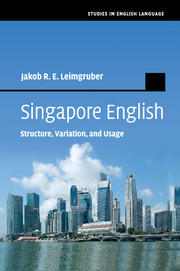Book contents
- Frontmatter
- Dedication
- Contents
- List of figures
- List of tables
- Acknowledgements
- List of abbreviations, glosses, and symbols
- 1 Introduction: Singapore and its Englishes
- 2 Variation in Singapore English: old and new models
- 3 Description: phonology and lexicon
- 4 Description: grammar
- 5 Indexicality: a model for Singapore?
- 6 Conclusion: the variety as a structural unit
- Appendix A Chinese romanisation
- Appendix B Informants
- Appendix C Chinese languages
- References
- Author index
- Subject index
5 - Indexicality: a model for Singapore?
Published online by Cambridge University Press: 05 July 2013
- Frontmatter
- Dedication
- Contents
- List of figures
- List of tables
- Acknowledgements
- List of abbreviations, glosses, and symbols
- 1 Introduction: Singapore and its Englishes
- 2 Variation in Singapore English: old and new models
- 3 Description: phonology and lexicon
- 4 Description: grammar
- 5 Indexicality: a model for Singapore?
- 6 Conclusion: the variety as a structural unit
- Appendix A Chinese romanisation
- Appendix B Informants
- Appendix C Chinese languages
- References
- Author index
- Subject index
Summary
As the previous chapters have shown, the variation in Singapore English between what has, traditionally, been called ‘Standard English’ on the one hand and ‘Singlish’ on the other hand is less than straightforward. The diglossia approach, presented in Section 2.1.3, took a domain-based distribution of two relatively clearly identified varieties as its premise, in which the choice of one variety over the other was motivated, essentially, by the nature of the exchange: university lectures, all but the least formal writing, public speaking, school and church settings, all called for the high (H) variety, Standard English, whereas everyday conversations, peer-group interaction in the playground, and generally all informal speech was carried out in the low (L) variety, Singlish. That this view of variation in Singapore English is unsatisfactory was subsequently explained at length, drawing mostly on data showing the problematic interplay of features ostensibly ‘belonging’ to both H and L in the same utterance.
Alternatives were found in Alsagoff's cultural orientation model (see Section 2.2.1), a view of the Singlish–Standard variation that takes into account the potential social meanings encoded in ‘switches’ from H to L and/or vice versa. Still, the view there was largely one that took a supposed ‘variety’ of English (either Standard or Singlish) as its unit of analysis (a point further addressed in Chapter 6), and was also largely concerned with cultural orientation (thence the name of the model), rather than with an overarching theory that could explain all of the social meanings potentially indexed through the various features used.
- Type
- Chapter
- Information
- Singapore EnglishStructure, Variation, and Usage, pp. 100 - 113Publisher: Cambridge University PressPrint publication year: 2013



